Hello and welcome to ‘Focused on Feld’. In my Focused on Feld series of reviews, I am working my way through Stefan Feld’s entire catalogue. Over the years, I have hunted down and collected every title he has ever put out. Needless to say, I’m a fan of his work. I’m such a fan, in fact, that when I noticed there were no active Stefan Feld fan groups on Facebook, I created one of my own.
Today we’re going to talk about 2022’s New York City, his 35th game.
New York City*, the third game in the lauded Stefan Feld City Collection (SFCC), is a re-implementation of 2013’s Rialto. Of the first four games in the SFCC, New York City is the only one to not also include a solitaire variant or any kind of bonus modules. But that doesn’t mean the game hasn’t seen an almost complete overhaul.
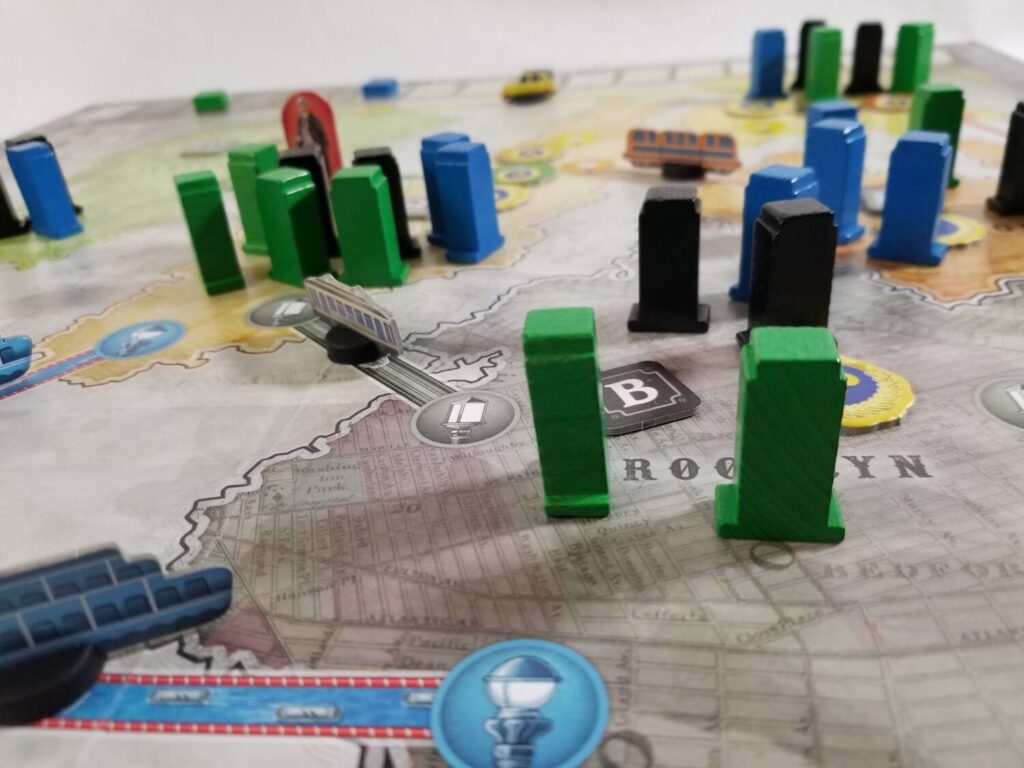
In the following review, I am going to focus solely on What’s Changed?, and What’s New? To fully understand how these changes and additions affect the gameplay, it helps to have an understanding of how Rialto is played. If you’re unfamiliar with the source material, I suggest you go check out my review of Rialto and come back.
*Interestingly enough, this is not the first New York themed re-implementation of a game published by Queen Games. In 2011, Queen Games released a game called New York which was a re-implementation of the 2003 Spiel des Jahres winner, Alhambra.
The Basics
Pound for pound, mechanically, New York City is almost exactly the same as Rialto. In fact, if you put them side by side and describe them and their phases, aside from a few changes in terminology, they’re virtually indistinguishable.
New York City |
Rialto |
| Description: Players use cards to add skyscrapers to the city’s boroughs, in a bid for area control, in order to score the most points. | Description: Players use cards to add their councilmen to the city’s districts, in a bid for area control, in order to score the most points. |
| Phase 0: Spent money is returned to the supply. New Prestige tiles are revealed. The Mayor moves to a new borough. Cards are prepared. | There is no Phase 0. |
| Phase 1: Cards are selected.
Phase 1 characters are activated during this phase. |
Phase 1: Spent money is returned to the supply. The District token moves to a new district. Cards are prepared and selected.
Phase 1 buildings are activated during this phase. |
| Phase 2: Players bid for the actions. The winner becomes the first player for the next action bid and receives a bonus. The actions are:
1. Press – move 1 step along the Press track per card played (bonus: 1 extra step). 2. Dollars– collect 1 dollar per card played (bonus: 1 extra dollar). 3. Elevator – take a character from the elevator display equal to or lower than the total of the number of cards played (bonus: add +1 to the number of cards played). 4. Building Plans – move 1 Skyscraper matching your color from the general supply to your personal supply per card played (bonus: 1 extra Skyscraper). 5. Prestige – earn 1 victory point per card played (bonus: select one of the Prestige tokens from the display. Select one of the vessels matching its color. Place the Prestige tile into one of the boroughs connected by the vessel and collect the vessel. Then, place one of your Skyscrapers into the borough). 6. Skyscrapers – move 1 Skyscraper from your personal supply to the current borough per each card played (bonus: +1 extra Skyscraper may be placed). Phase 2 characters are activated during this phase. |
Phase 2: Players bid for the actions. The winner becomes the first player for the next action bid and receives a bonus. The actions are:
1. Doge – move 1 step along the Doge track per card played (bonus: 1 extra step). 2. Gold – collect 1 coin per card played (bonus: 1 extra coin). 3. Building – take a building from the supply equal to or lower than the total of the number of cards played (bonus: add +1 to the number of cards played). 4. Bridge – earn 1 victory point per card played (bonus: +1 extra victory point AND play the next Bridge tile between any two districts that do not have a tile between them). 5. Gondola – move 1 Councilman matching your color from the general supply to your personal supply per card played (bonus: place a Gondola tile between any two districts that do not have a tile between them. Then place a Councilman into one of these districts. If you are the first person to have Councilmen in each district in one of the two district groups, then you receive the five point bonus). 6. Councilman – move 1 Councilman from your personal supply to the current district per each card played (bonus: +1 extra Councilman may be placed). Phase 2 buildings are activated during this phase. |
| Phase 3: Phase 3 characters are activated during this phase. | Phase 3: Phase 3 buildings are activated during this phase. |
What’s Changed?
Despite the similarities, there are some noticeable differences.
For instance, you may have noticed that actions 4 and 5 have been transposed.
You may have also noticed that buildings have been replaced with characters. Thematically, you’re paying the characters to perform their actions. This makes a lot more sense thematically than giving money to an inanimate building.
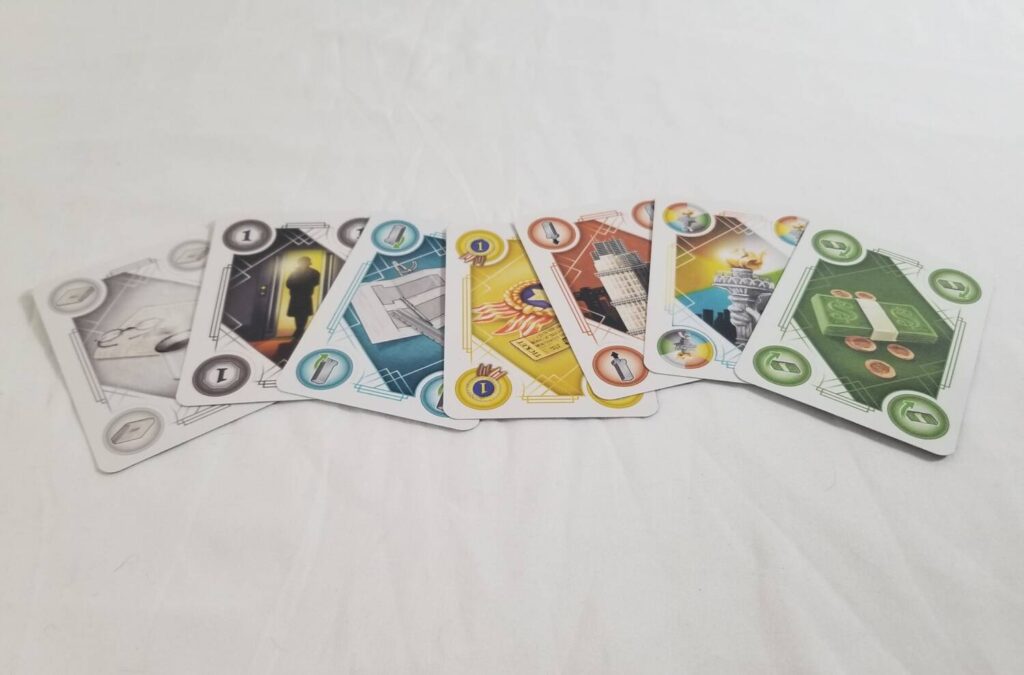
Also, the two 5-point bonuses that were awarded in Rialto for being the first to place a councilman into all of the blue or orange districts have been removed. These have been replaced by the Statue of Liberty token which awards a large bonus to the first person to have a skyscraper in every borough, while awarding other players who manage the feat later a much smaller amount of points.
And, of course, there’s the theme. Instead of placing councilmen into a district in order to gain influence there, the players are competing to build skyscrapers in the various boroughs of a city well known for its skyscrapers. As you can well imagine, the game has seen an artistic overhaul as a result. But, it’s largely the same layout. Thank goodness for the new artwork, too. For instance, in my review of Rialto, I complained about the lackadaisical artwork of the victory point track and how confusing it was as a result. In New York City, there’s no confusion. Because of the artwork, you always know precisely where you stand.
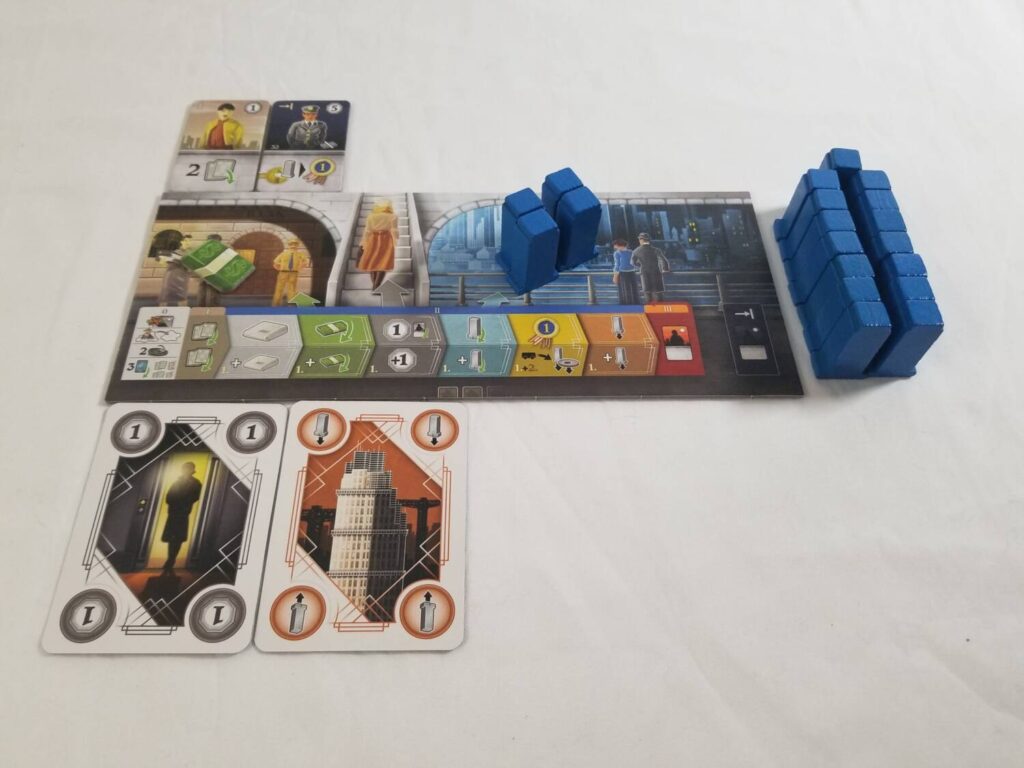
Aside from thematic and mechanical changes, there is a change in the physical components as well. The player boards have been re-designed to make them more functional. The phase tracker which lived on the main board in Rialto has been moved to the player boards and the building/character storage has been moved off of the boards into the space above the board, resulting in a much less cluttered feel.
What’s New?
Vessels: Gone are the Gondola tiles from Rialto. Their purpose has been reimagined and revamped in the form of vessels. I discussed how the vessels are used in the game previously. In addition to opening up new scoring opportunities, the vessels also place limitations on where bonus tiles can be placed, a limitation which did not exist in Rialto.
Dummy Player: Each borough has 2 dummy player skyscrapers placed into it before the game even begins. And the dummy player occupies a space on the Doge track (called the ‘Press track’ in this game) which never moves. These pieces are just there to cause the other players consternation. And they do so to good effect. In a 2-player game of Rialto, for instance, you were always guaranteed to come in second place in any district in which you had a councilman.
Not so in New York City. While 2 skyscrapers may not seem like much, it’s a difficult hurdle to overcome. You’ll often find yourself tied with the dummy player, but that’s all for naught if you haven’t managed to pass them up on the Press track. It’s an interesting change that presents a few extra decision points, making for a more invested experience.
The Reserve: During setup, each player is dealt two cards at random which are stored beneath their Player boards as a reserve. During Phase 2, players may freely exchange cards from their hands with cards in their reserves. This not only gives the player more flexibility during the course of the round, but it also allows them to set themselves up for future rounds.
In Rialto, you just had to deal with what you were given. This agency over your fate is a welcome change. And this brings me to what is the biggest change of all…
Card Preparation and Selection: In Rialto, several card rows would be created during each round by randomly drawing 6 cards out of the deck. Then the players would take turns drafting a grouping of these cards, with the person in last place always getting stuck with whatever everyone else didn’t want (not a great feeling at all). You would also receive two cards randomly drawn from the deck and you could holdover cards from previous rounds (this holdover has been replaced by The Reserve, presumably).
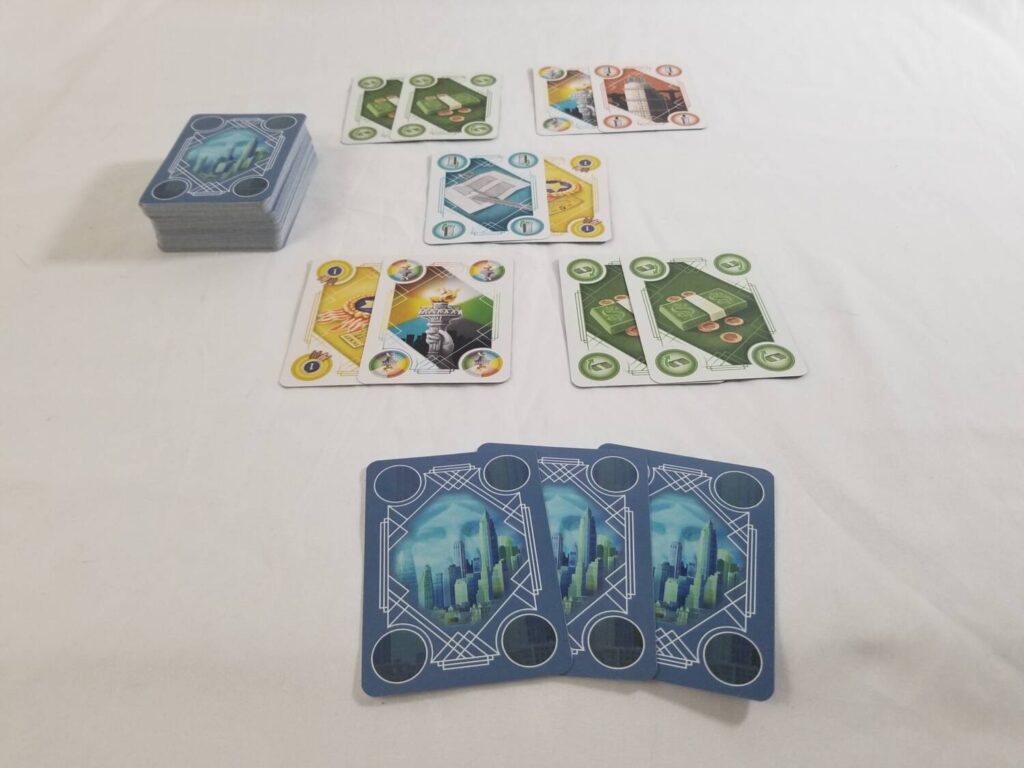
In New York City, the drafting is VERY different. Instead of several rows of six cards being created, multiple sets of two cards each are created. Players receive 3 cards each from the draw pile. Then, a snake draft is performed wherein players select a single set of cards to add to their hands. This ensures a much more even, and fair, distribution of cards.
Thoughts
Were it not for the ways that cards are prepared and selected, there would be very little for me to recommend New York City over Rialto. The two games are so similar that, aside from the theme, there’s not much to distinguish the two. But, as a result, New York City is the much better game. And that’s not just because of the card draft. There are other aspects that set New York City above Rialto as well, but none of them are as critical as the way the cards are handled.
For instance, the switch from buildings to character cards just makes so much more thematic sense. I’m not sure the elevator board was really necessary, but it does help to keep things more organized. Surprisingly, Feld, who never seems to miss a trick, has overlooked a golden opportunity here. I would have loved to see a character ability or two that would have allowed you to reposition character cards to make them cheaper, or more expensive, to obtain. People ride up and down in elevators right? Why not introduce a way to simulate this?
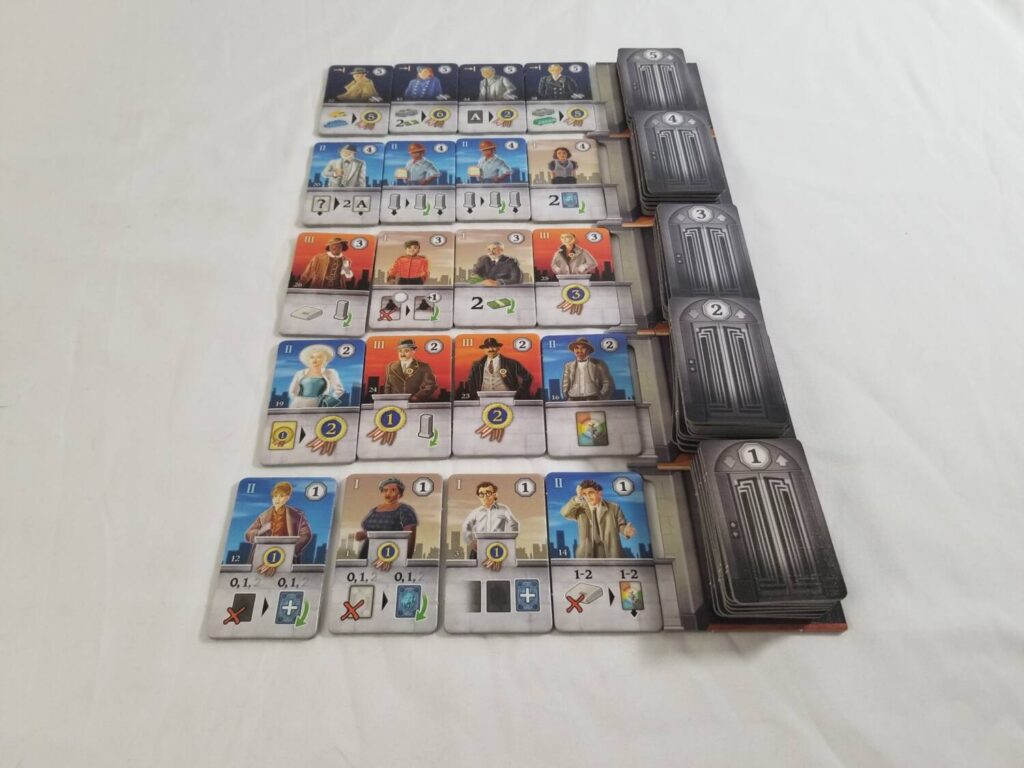
I also quite like the addition of the vessels. While they’re not totally necessary, they have served to create new scoring opportunities in the guise of new and interesting character cards that award you at the end of the game for having specific sets of vessels. In fact, with the exception of the elevator, each small change to the game has resulted in a new character card that experiments or interacts with those changes in some way. In Rialto, you’re stuck with the same limited sets of buildings each and every game. In New York City, it’s highly likely there are some character cards you may not ever see during the course of the game.
But, does all of this mean that New York City is a great game? While it’s certainly better than Rialto, it hasn’t changed my opinion about this game’s place in the Feldiverse overall. Rialto has never been my favorite Feld game, or even close to it. And New York City hasn’t changed that any. It’s a fine game, but it isn’t one that’s likely to see a lot of play. There are much better Feld games to choose from. But, given the choice between New York City and Rialto, New York City will always be the game I choose.











